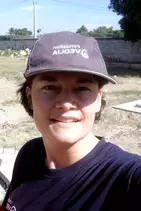Merel de Wildt, engineering project manager at Veolia Water Technologies, managed to go on a mission to Haiti between two lockdown periods in 2020. With a key word to guide her: adaptability.

You registered as a Veoliaforce volunteer just a few months before leaving for the field. How did you approach this mission?
Merel de Wildt: In fact, I waited until I was a little more available, once the children had got a little bit older, to register in May 2020 during the first lockdown. I followed the training a few months later, which gave me the opportunity to learn about the project in Haiti and to discuss the possibility of a departure in the field, which was made more complicated by the second lockdown. And I finally left for three weeks.
Have you worked on biodisc installations before?
MdeW: The biodisc is a fairly simple and rustic type of equipment, suitable for small communities, such as ski resorts for example. I had hardly ever used it in my daily work in France, but the principles of the wastewater treatment process as well as the start-up procedures remain the same. And then, as things turned out, the mission ultimately did not only concern the setting up of the biodisc system...
Why do you say that?
MdeW: We suspected that the question of how to power the biodisc system was going to be tricky. Putting in the industrial wiring required to install this type of electrical box is not a skill that is easy to find in Haiti. The installation took a lot longer than we expected. We tried to find solutions but, in the end, it took three weeks. The challenge in the end was how to properly wire the box so that the biodisc could start. The “priming” (filling the installation with water) could only take place once this issue had been sorted out.
That’s the reason you had come for, though. Wasn't that frustrating?
MdeW: Not at all: the aim of a Veoliaforce mission is to move a project forward. So we try to find solutions, we analyse the situation, we call colleagues. Fortunately, I can read electrical diagrams, so I was able to transcribe the issues. The Médecins Sans Frontières representative on site was also very involved in unblocking problems. An important step was taken once the electrical part was completed and I managed to fill the installation with water 30 minutes before my departure for the airport! At the same time, I had been able to carry out analyses on raw water and prepare the analysis protocols to be done on site so that my MSF contact, who was staying a week longer, could continue with the start-up of the process.
How did you organise your absence during the trip, both at the office and at home?
MdeW: At work, I had organized an action plan so that everyone I spoke to knew who to talk to in my absence. This is the sine qua non for going on a three-week mission. And at home, well ... I had anticipated! As soon as I registered, we agreed, with my husband, on how to organise things in the event of a mission. Becoming a Veoliaforce volunteer is a choice you cannot make alone when living with your family.


